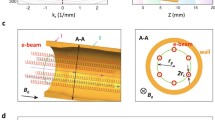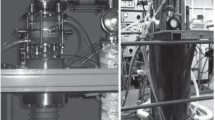Abstract
Theoretical and experimental investigation of broadband step-frequency tuning in a prototype sub-terahertz gyrotron for advanced plasma fusion research is presented. The possibilities of successive excitation of various operating modes in a conventional gyrotron cavity are considered. Restrictions of the gyrotron capability due to properties of the electron beam formation and the radiation output systems are determined and discussed. Successful excitation of modes with frequencies range of 133–250 GHz with output power not less than 35 kW was demonstrated in experiments.






Similar content being viewed by others
Data Availability
Data are available on request from the authors.
References
C. Darbos et al., “Status of the ITER Electron Cyclotron Heating and Current Drive System,” J. Infrared, Millimeter, Terahertz Waves, vol. 37, no. 1, pp. 4–20, Jan. 2016, doi: https://doi.org/10.1007/s10762-015-0211-3.
Y. S. Bae et al., “Status of KSTAR Electron Cyclotron Heating System,” Fusion Sci. Technol., vol. 52, no. 2, pp. 321–333, Aug. 2007, doi: https://doi.org/10.13182/FST07-A1510.
“The year of the gyrotron.” https://www.iter.org/newsline/-/2931.
J. Jelonnek et al., “From Series Production of Gyrotrons for W7-X Toward EU-1 MW Gyrotrons for ITER,” IEEE Trans. Plasma Sci., vol. 42, no. 5, pp. 1135–1144, May 2014, doi: https://doi.org/10.1109/TPS.2014.2301839.
A. Litvak, K. Sakamoto, and M. Thumm, “Innovation on high-power long-pulse gyrotrons,” Plasma Phys. Control. Fusion, vol. 53, no. 12, p. 124002, Dec. 2011, doi: https://doi.org/10.1088/0741-3335/53/12/124002.
E. Poli et al., “Electron-cyclotron-current-drive efficiency in DEMO plasmas,” Nucl. Fusion, vol. 53, no. 1, p. 013011, Jan. 2013, doi: https://doi.org/10.1088/0029-5515/53/1/013011.
J. Jelonnek et al., “Design considerations for future DEMO gyrotrons: A review on related gyrotron activities within EUROfusion,” Fusion Eng. Des., vol. 123, pp. 241–246, Nov. 2017, doi: https://doi.org/10.1016/j.fusengdes.2017.01.047.
R. Ikeda et al., “Development of multi-frequency gyrotron for ITER and DEMO at QST,” in 2016 41st International Conference on Infrared, Millimeter, and Terahertz waves (IRMMW-THz), Sep. 2016, pp. 1–2, doi: https://doi.org/10.1109/IRMMW-THz.2016.7758384.
P. C. Kalaria et al., “RF Behavior and Launcher Design for a Fast Frequency Step-tunable 236 GHz Gyrotron for DEMO,” Frequenz, vol. 71, no. 3–4, Jan. 2017, doi: https://doi.org/10.1515/freq-2016-0212.
V. A. Flyagin, A. V. Gaponov, I. Petelin, and V. K. Yulpatov, “The gyrotron,” IEEE Trans. Microw. Theory Tech., vol. 25, no. 6, p. 514, Jun. 1977, doi: https://doi.org/10.1109/TMTT.1977.1129149.
K. E. Kreischer, B. G. Danly, J. B. Schutkeker, and R. J. Temkin, “The Design of Megawatt Gyrotrons,” IEEE Trans. Plasma Sci., vol. 13, no. 6, pp. 364–373, 1985, doi: https://doi.org/10.1109/TPS.1985.4316447.
V. E. Zapevalov and A. N. Kuftin, “Powerful 80–150 GHz Gyrotrons,” in Int. Workshop “Strong Microwaves in Plasmas,” 1990, pp. 726–738.
V. L. Bratman, Y. K. Kalynov, and V. N. Manuilov, “Large-Orbit Gyrotron Operation in the Terahertz Frequency Range,” Phys. Rev. Lett., vol. 102, no. 24, p. 245101, Jun. 2009, doi: https://doi.org/10.1103/PhysRevLett.102.245101.
Y. Tatematsu et al., “Development of Gyrotron FU CW GVII: a Second Harmonic, Multifrequency Gyrotron that Radiates Gaussian Beams,” J. Infrared, Millimeter, Terahertz Waves, vol. 41, no. 5, pp. 576–589, May 2020, doi: https://doi.org/10.1007/s10762-020-00681-7.
G. F. Brand, N. G. Douglas, M. Gross, J. Y. L. Ma, L. C. Robinson, and C. Zhiyi, “Tuneable millimeter-wave gyrotrons,” Int. J. Infrared Millimeter Waves, vol. 3, no. 5, pp. 725–734, Sep. 1982, doi: https://doi.org/10.1007/BF01009730.
K. D. Hong, G. F. Brand, and T. Idehara, “A 150–600 GHz step‐tunable gyrotron,” J. Appl. Phys., vol. 74, no. 8, pp. 5250–5258, Oct. 1993, doi: https://doi.org/10.1063/1.354265.
M. Thumm et al., “Frequency step-tunable (114–170 GHz) megawatt gyrotrons for plasma physics applications,” Fusion Eng. Des., vol. 53, no. 1–4, pp. 407–421, Jan. 2001, doi: https://doi.org/10.1016/S0920-3796(00)00519-6.
V. E. Zapevalov et al., “Development of a Prototype of a 1-MW 105-156-GHz Multifrequency Gyrotron,” Radiophys. Quantum Electron., vol. 47, no. 5/6, pp. 396–404, May 2004, doi: https://doi.org/10.1023/B:RAQE.0000046313.84364.3c.
V. E. Zapevalov, A. N. Kuftin, and V. K. Lygin, “Numerical simulation and experimental study of an electron-optical system of a megawatt gyrotron with step frequency tuning in the range 100–170 GHz,” Radiophys. Quantum Electron., vol. 50, no. 9, pp. 702–712, Sep. 2007, doi: https://doi.org/10.1007/s11141-007-0061-5.
N. A. Zavolsky, V. E. Zapevalov, A. S. Zuev, O. P. Plankin, A. S. Sedov, and E. S. Semenov, “Analysis of the Methods of Discrete and Smooth Frequency Tuning in Gyrotrons for Spectroscopy, on the Example of a Generator Operated in the 0.20–0.27 THz Frequency Range,” Radiophys. Quantum Electron., vol. 61, no. 6, pp. 436–444, Nov. 2018, doi: https://doi.org/10.1007/s11141-018-9905-4.
A. S. Zuev, V. E. Zapevalov, O. P. Plankin, and E. S. Semenov, “Optimization of a High-Power Subterahertz Gyrotron Tunable in a Wide Frequency Range Allowing for the Limitations Imposed by the Magnetic System,” Radiophys. Quantum Electron., vol. 62, no. 4, pp. 277–285, Sep. 2019, doi: https://doi.org/10.1007/s11141-019-09976-9.
S. Pan, C.-H. Du, X.-B. Qi, and P.-K. Liu, “Broadband terahertz-power extracting by using electron cyclotron maser,” Sci. Rep., vol. 7, no. 1, p. 7265, Dec. 2017, doi: https://doi.org/10.1038/s41598-017-07545-6.
Y. Yamaguchi et al., “Super Multi-Frequency Oscillations at Fundamental Harmonics With a Complex Cavity Gyrotron,” IEEE Electron Device Lett., vol. 41, no. 8, pp. 1241–1244, Aug. 2020, doi: https://doi.org/10.1109/LED.2020.3000640.
G. G. Denisov et al., “First experimental tests of powerful 250 GHz gyrotron for future fusion research and collective Thomson scattering diagnostics,” Rev. Sci. Instrum., vol. 89, no. 8, p. 084702, Aug. 2018, doi: https://doi.org/10.1063/1.5040242.
A. N. Kuftin, V. K. Lygin, V. N. Manuilov, B. V. Raisky, E. A. Solujanova, and S. E. Tsimring, “Theory of helical electron beams in gyrotrons,” Int. J. Infrared Millimeter Waves, vol. 14, no. 4, pp. 783–816, 1993, doi: https://doi.org/10.1007/BF02084288.
S. E. Tsimring, Electron Beams and Microwave Vacuum Electronics. Hoboken, NJ, USA: John Wiley & Sons, Inc., 2006.
N. A. Zavolsky, V. E. Zapevalov, and M. A. Moiseev, “Efficiency Enhancement of the Relativistic Gyrotron,” Radiophys. Quantum Electron. 2001 444, vol. 44, no. 4, pp. 318–325, Apr. 2001, doi: https://doi.org/10.1023/A:1010422204317.
A. V. Chirkov, G. G. Denisov, and A. N. Kuftin, “Perspective gyrotron with mode converter for co- and counter-rotation operating modes,” Appl. Phys. Lett., vol. 106, no. 26, p. 263501, Jun. 2015, doi: https://doi.org/10.1063/1.4923269.
N. S. Ginzburg, M. Y. Glyavin, N. A. Zavol’skii, V. E. Zapevalov, M. A. Moiseev, and Y. V. Novozhilova, “A proposal to use reflection with delay for achieving the self-modulation and stochastic regimes in millimeter-wave gyrotrons,” Tech. Phys. Lett., vol. 24, no. 6, pp. 436–438, Jun. 1998, doi: https://doi.org/10.1134/1.1262164.
T. M. Antonsen, S. Y. Cai, and G. S. Nusinovich, “Effect of window reflection on gyrotron operation,” Phys. Fluids B Plasma Phys., vol. 4, no. 12, pp. 4131–4139, Dec. 1992, doi: https://doi.org/10.1063/1.860320.
O. Dumbrajs, M. Yu Glyavin, V. E. Zapevalov, and N. A. Zavolsky, “Influence of reflections on mode competition in gyrotrons,” IEEE Trans. Plasma Sci., vol. 28, no. 3, pp. 588–596, 2000, doi: https://doi.org/10.1109/27.887680.
N. Kharchev et al., “Influence of Controlled Reflected Power on Gyrotron Performance,” J. Infrared, Millimeter, Terahertz Waves, vol. 36, no. 12, pp. 1145–1156, Dec. 2015, doi: https://doi.org/10.1007/s10762-015-0206-0.
G. G. Denisov et al., “Multi-Frequency Gyrotron with BN Brewster Window,” in 2006 Joint 31st International Conference on Infrared Millimeter Waves and 14th International Conference on Teraherz Electronics, Sep. 2006, pp. 75–75, doi: https://doi.org/10.1109/ICIMW.2006.368283.
G. Gantenbein et al., “First Operation of a Step-Frequency Tunable 1-MW Gyrotron With a Diamond Brewster Angle Output Window,” IEEE Trans. Electron Devices, vol. 61, no. 6, pp. 1806–1811, Jun. 2014, doi: https://doi.org/10.1109/TED.2013.2294739.
X. Yang et al., “Analysis of Transmission Characteristics for Single and Double Disk Windows,” Int. J. Infrared Millim. Waves 2003 245, vol. 24, no. 5, pp. 619–628, May 2003, doi: https://doi.org/10.1023/A:1023359612449.
S. Jawla et al., “Continuously Tunable 250 GHz Gyrotron with a Double Disk Window for DNP-NMR Spectroscopy,” J. Infrared, Millimeter, Terahertz Waves 2012 341, vol. 34, no. 1, pp. 42–52, Nov. 2012, doi: https://doi.org/10.1007/S10762-012-9947-1.
S. N. Vlasov, E. V. Koposova, S. Y. Kornishin, V. V. Parshin, D. A. Perminov, and E. A. Serov, “Wideband Windows for Millimeter- and Submillimeter-Wave Vacuum Devices,” Radiophys. Quantum Electron., vol. 63, no. 2, pp. 106–113, Jul. 2020, doi: https://doi.org/10.1007/s11141-020-10039-7.
M. D. Proyavin, D. I. Sobolev, V. V. Parshin, V. I. Belousov, S. V. Mishakin, and M. Y. Glyavin, “Study of 3D-Printed Dielectric Barrier Windows for Microwave Applications,” Electronics, vol. 10, no. 18, p. 2225, Sep. 2021, doi: https://doi.org/10.3390/electronics10182225.
Funding
This work was supported by Russian Federation President Grant (project number MK-3413.2021.1.2).
Council on grants of the President of the Russian Federation,MK-3413.2021.1.2,Andrey Fokin
Author information
Authors and Affiliations
Corresponding author
Ethics declarations
Competing Interests
The authors declare no competing interests.
Additional information
Publisher's Note
Springer Nature remains neutral with regard to jurisdictional claims in published maps and institutional affiliations.
Rights and permissions
About this article
Cite this article
Zuev, A.S., Fokin, A.P., Ananichev, A.A. et al. Realization of an Octave Frequency Step-Tuning of Sub-terahertz Gyrotron for Advanced Fusion Research. J Infrared Milli Terahz Waves 42, 1131–1141 (2021). https://doi.org/10.1007/s10762-021-00832-4
Received:
Accepted:
Published:
Issue Date:
DOI: https://doi.org/10.1007/s10762-021-00832-4




